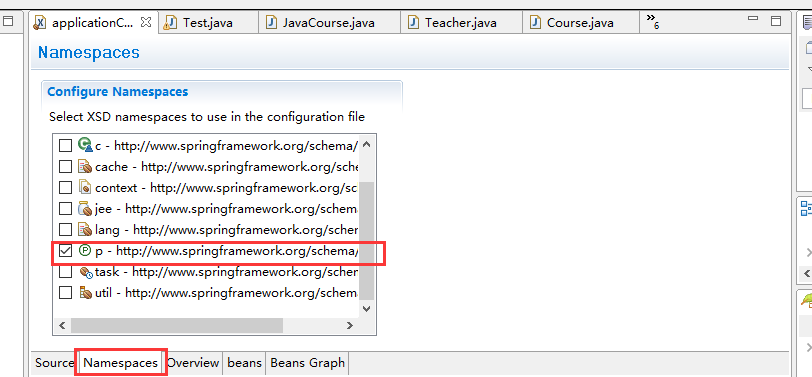一、第一种注入(set注入):
创建实体类,Teacher:
package org.ruangong.entity;
public class Teacher {
private String name;
private int age;
public String getName() {
return name;
}
public void setName(String name) {
this.name = name;
}
public int getAge() {
return age;
}
public void setAge(int age) {
this.age = age;
}
}
创建实体类,Course:
package org.ruangong.entity;
public class Course {
private String cname;
private int chour;
private Teacher teacher;
public String getCname() {
return cname;
}
public void setCname(String cname) {
this.cname = cname;
}
public int getChour() {
return chour;
}
public void setChour(int chour) {
this.chour = chour;
}
public Teacher getTeacher() {
return teacher;
}
public void setTeacher(Teacher teacher) {
this.teacher = teacher;
}
@Override
public String toString() {
return "Course [cname=" + cname + ", chour=" + chour + ", teacher=" + teacher.getName() + teacher.getAge()+"]";
}
}
在applicationContext.xml文件中添加bean标签。
<bean id="teacher" class="org.ruangong.entity.Teacher"> <property name="name" value="王建民"></property> <property name="age" value="50"></property> </bean> <bean id="course" class="org.ruangong.entity.Course"> <property name="cname" value="java"></property> <property name="chour" value="2"></property> <property name="teacher" ref="teacher"></property> </bean>
其中的ref=“”,对应对象值。将teacher对象注入到course对象中。
二、第二中注入(构造器注入):
在Teacher实体中添加构造方法。
public Teacher(String name, int age) {
super();
this.name = name;
this.age = age;
}
在Course实体中添加构造方法:
public Course(String cname, int chour, Teacher teacher) {
super();
this.cname = cname;
this.chour = chour;
this.teacher = teacher;
}
在之前的applicationContext.xml文件的id为teacher和course标签重新添加构造方法。
<bean id="teacher" class="org.ruangong.entity.Teacher"> <!-- 通过set注入 --> <!-- <property name="name" value="王建民"></property> <property name="age" value="50"></property> --> <!-- 通过构造器注入 --> <constructor-arg value="刘丹"></constructor-arg> <constructor-arg value="48"></constructor-arg> </bean> <bean id="course" class="org.ruangong.entity.Course"> <!-- 通过set注入 --> <!-- <property name="cname" value="java"></property> <property name="chour" value="2"></property> <property name="teacher" ref="teacher"></property> --> <!-- 通过构造器注入 --> <constructor-arg value="PHP"></constructor-arg> <constructor-arg value="5"></constructor-arg> <constructor-arg ref="teacher"></constructor-arg> </bean>
<constructor>的value顺序和构造方法的属性值严格一致。
或者可以在constructor标签的后面添加index="key",key值来控制属性顺序。
或者添加name="key",key来控制属性名。
三、第三种注入(P值注入)

生成P的标签。
<bean id="teacher" class="org.ruangong.entity.Teacher" p:name="刘立嘉" p:age="60"> <!-- 通过set注入 --> <!-- <property name="name" value="王建民"></property> <property name="age" value="50"></property> --> <!-- 通过构造器注入 --> <!-- <constructor-arg value="刘丹"></constructor-arg> <constructor-arg value="48"></constructor-arg> --> </bean> <bean id="course" class="org.ruangong.entity.Course" p:cname="统一建模" p:chour="6" p:teacher-ref="teacher"> <!-- 通过set注入 --> <!-- <property name="cname" value="java"></property> <property name="chour" value="2"></property> <property name="teacher" ref="teacher"></property> --> <!-- 通过构造器注入 --> <!-- <constructor-arg value="PHP"></constructor-arg> <constructor-arg value="5"></constructor-arg> <constructor-arg ref="teacher"></constructor-arg> --> </bean>
四、集合类型值注入:
创建集合实体,AllCollectionType:
package org.ruangong.entity;
import java.util.Arrays;
import java.util.List;
import java.util.Map;
import java.util.Properties;
import java.util.Set;
public class AllCollectionType {
private List<String> list;
private String[] array;
private Map<String,String> map;
private Set<String> set;
private Properties props;
public List<String> getList() {
return list;
}
public void setList(List<String> list) {
this.list = list;
}
public String[] getArray() {
return array;
}
public void setArray(String[] array) {
this.array = array;
}
public Map<String, String> getMap() {
return map;
}
public void setMap(Map<String, String> map) {
this.map = map;
}
public Set<String> getSet() {
return set;
}
public void setSet(Set<String> set) {
this.set = set;
}
public Properties getProps() {
return props;
}
public void setProps(Properties props) {
this.props = props;
}
@Override
public String toString() {
return "AllCollectionType [list=" + list + ", array=" + Arrays.toString(array) + ", map=" + map + ", set=" + set
+ ", props=" + props + "]";
}
}
在applicationContext.xml文件中:
<bean id="collection" class="org.ruangong.entity.AllCollectionType"> <!-- 通过set方式赋值 --> <property name="list"> <list> <value>篮球</value> <value>足球</value> <value>乒乓球</value> </list> </property> <property name="array"> <array> <value>篮球_array</value> <value>足球_array</value> <value>乒乓球_array</value> </array> </property> <property name="map"> <map> <entry> <key> <value> foot </value> </key> <value>足球</value> </entry> <entry> <key> <value> basket </value> </key> <value>篮球球</value> </entry> <entry> <key> <value> pingpang </value> </key> <value>足球</value> </entry> </map> </property> <property name="set"> <set> <value>篮球_set</value> <value>足球_set</value> <value>乒乓球_set</value> </set> </property> <property name="props"> <props> <prop key="foot4">足球</prop> <prop key="basket4">篮球</prop> <prop key="pp4">乒乓球</prop> </props> </property> </bean>
test中进行测试:
public static void collectionDemo(){
ApplicationContext context = new ClassPathXmlApplicationContext("applicationContext.xml");
AllCollectionType type = (AllCollectionType)context.getBean("collection");
System.out.println(type);
}
